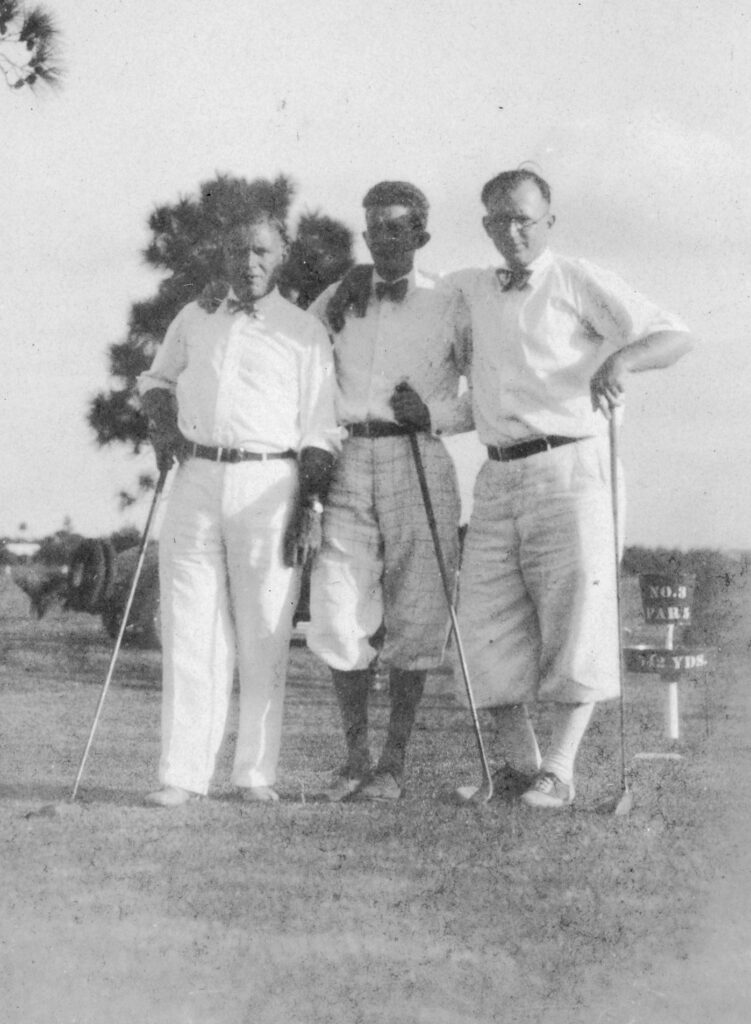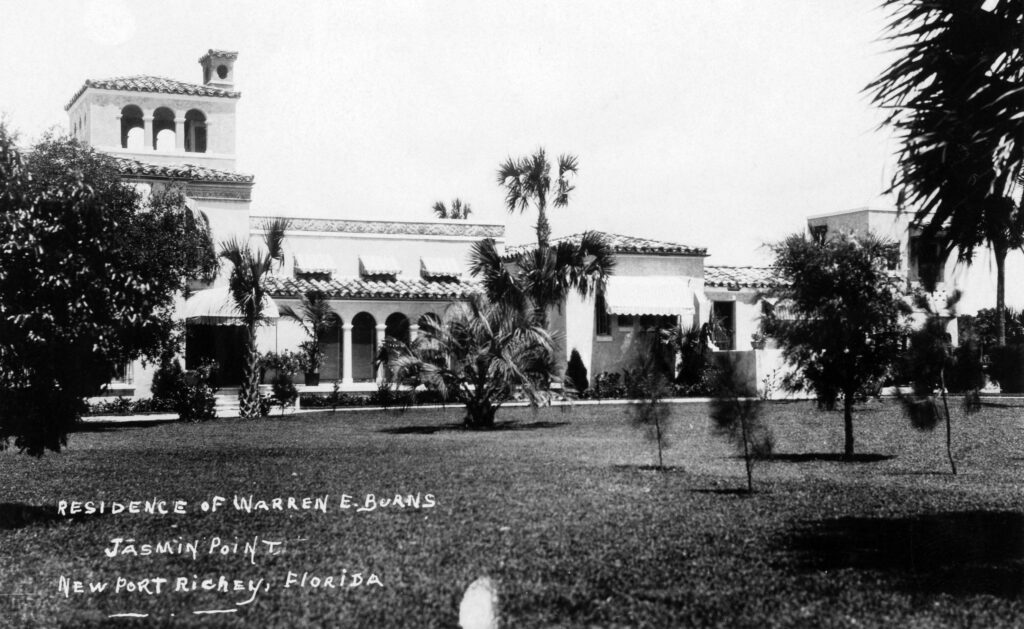Warren Elmo Burns
This article was published on 14 Mar 2024 by Paul Herman, digital media archivist, West Pasco Historical Society

Warren Elmo Burns was born in Milford Junction, Indiana, on July 10, 1876. He grew up in that small suburb of Goshen, Indiana, and met his first wife there. He married Ellen H. Rogers on April 26, 1898.
He was at the time of his marriage a member of company G of the Illinois National Guard stationed in Springfield. He rose through the ranks to captain of Koch’s Provisional Regiment during the Spanish-American War.
Warren’s father, Jerome, had invented a product called “Cosmo Buttermilk Soap” late in the nineteenth century, eventually selling the business to the Pennsylvania Soap Company. In 1900, Warren was employed at his father’s soap factory. This experience may have spurred Warren’s interest in the fragrance and perfume industry.
Burns partnered with Carl Schaetzer and Williard A. Walsh in 1906 to establish a perfume business. In 1909, Burns moved to New York City, and the company was incorporated there under the name Morana Incorporated. Schaetzer was in charge of the production department, Walsh was the treasurer and in charge of sales. And Warren Burns was vice president and took care of foreign contacts and business.
On May 14, 1910, Warren married Lola Dean Lohnes in Wilmington, Delaware. Not much is known about the relationship between Warren and Lola. They never had children. But Lola seemed to be involved with Warren’s business matters. Her name appears on many legal documents, land records, and business contracts. There is little doubt, however, that he admired her very much … naming his personal yacht that he maintained in New Port Richey the “Lola Dean”.
Warren Burns traveled extensively in Europe – particularly France – arranging deals and mergers to strengthen his perfume business. He worked extensively with the USDA to import flower varieties to the United States to determine if the essential oils they produced could be used in fragrances and perfumes. In 1920, Burns reported a total personal income of $120,137.
Morana eventually merged with International Flavors & Fragrances Inc., which is still a major player today – supplying fragrances for famous name brand perfumes, scented soaps and detergents.
Warren’s devotion to his country and military service that he demonstrated as a member of the National Guard when he was in his twenties, was not abated by his business interests. During World War I he was a lieutenant of the American Protective League from 1917 to 1919. His contribution was recognized by being awarded a “Certificate of Exceptional Service” jointly by the American Protective League and the United States Department of Justice.
About 1917, Warren Burns purchased property consisting of 32 acres overlooking the Cotee River that he named “Burns Point”. His brother Clyde F. Burns, and his now disabled father Jerome J. Burns, moved there to oversee the estate while Warren was taking care of his perfume business in New York City.
The property Burns owned spanned for a half mile along the western bank of the river, and included a citrus grove with 280 orange and grapefruit trees, and houses for Clyde and Jerome. By the early 1920s, plans were well underway to build Warren’s $60,000 winter estate there and further develop the property.
One of Burns’ responsibilities during his foreign travels was to procure seeds, flowers and other plants that could be used in the production of perfumes. Although not formally trained as a botanist, he became a specialist in the study and growing of flowers to determine if the essential oils they produced could be used in fragrances. He planted a rose garden on his Jasmine point estate for this purpose. He experimented with many different types of flowers, including geraniums, lavender, hibiscus, bougainvillea and oleander. But one of his favorites was Jasmine. In 1920, he imported jasmine plants from Grasse, France, for his experiments. Grasse Commune in France is widely considered as the “perfume capital of the world”.

By spring of 1920, Warren Burns, who was now wintering in New Port Richey, had expanded his holdings at Burns Point and had purchased additional property upstream on the river that he planned to develop into the “Old Grove” subdivision. To do this, in March of 1923 he formed the Old Grove Company with a capital expenditure of $50,000. Warren was the president of the company, and his wife Lola’s brother, Grant Herbert Lohnes, was the vice president. Lola was also a shareholder of the company.
Located east of Madison Street with a mile of frontage along the south bank of the Pithlachascotee River, it was sold as an elite subdivision of elegant houses. Located just a quarter mile east of the newly built Gulf High School in 1922, Burns was responsible for extending Gulf Drive from the high school on Grand Boulevard to his Old Grove subdivision.
By the mid 1920s, Burns was now retired from his perfume business in New York City, and had become something of a real estate broker in New Port Richey. In the early 1920s, he was the largest property owner in New Port Richey – other than George Sims’ Port Richey Land Company.
Warren Burns’ signature project was Jasmine Point. Located along the west bank of the Pithlachascotee River just north of the downtown area, it included his property at Burns Point and a large swath of land to the south of there between the river and what is now US Highway 19. To help with the development of the Jasmine Point subdivision, Burns formed a partnership in late 1925 with James Becker – a business associate he knew in New York. They went into business together as the Burns-Becker Realty Company. Shortly afterward they began another business called the West Florida Bond & Mortgage Company to raise capital for their real estate ventures.
Becker was more than just a partner to Warren Burns. They were also friends and neighbors. James had also committed to making New Port Richey his winter home, and built his own house along the river on Jasmine Point property. Both Warren Burn’s and James Becker’s houses were designed by famous Sarasota architect Thomas R. Martin.
A large tract of the Jasmine Point land was devoted to an 18 hole championship golf course. Burns negotiated a deal with golfer Gene Sarazen – the best, and most famous, golfer in the world at that time – to design and manage the course. Residential lots in the subdivision were sold to many rich and famous people including Gene Sarazen and silent film actor Thomas Meighan.
In addition to Jasmine Point and the Old Grove Subdivision, Warren Burns also had land holdings north of Massachusetts Avenue in an area historically referred to as the “Old Richey Grove”. This was originally the land occupied by Aaron Richey’s grove – which was the first citrus grove planted in West Pasco County. It was located midway between New and Old Port Richey across the river from Jasmine Point.
Warren Burns was instrumental in the development of New Port Richey in other ways, too. In 1920 he had plans to start an electric utility in the city. He asked the Womans’s Civic Club for help in building support for his plan, which started with the installation of eight street lamps in various locations around the downtown area. The new electric company, named the Gulf Utilities Company, expanded to generate electricity for the entire town. It also operated an ice plant and generated steam for local businesses.
Burns and his partner Becker were also the prime movers in a project to build a new community hotel in 1926. They formed a corporation known as Community Hotel, Inc. to raise money for the hotel, and plan its construction. Directors of the corporation consisted of many influential people in the city of New Port Richey. Architect Thomas R. Martin, who designed Burns’ and Becker’s houses, was hired to create the design. In July of that year, ground was broken for the hotel. And in November the board of directors voted to name the new hotel “The Hacienda”.
Warren Burns was president of the New Port Richey city council in 1928. He was also acting mayor of the city for a short time in November of that year due to an absence of mayor James W. Clark Jr.
In 1929, Warren Burns was the vice-president of the Gulf Coast Highway Association. This was an organization created to support the creation of a Gulf Coast highway running north-south along the west coast of Florida, including Pasco County. The organization failed in its early efforts – but eventually their plans came to fruition with the extension of US Highway 19 through New Port Richey.
His civic and fraternal interests were well known within the community of West Pasco County. He was a high-ranking Mason, and a member of the “Pearl of the West” Masonic Blue lodge located in New Port Richey. He was also a member of the Shriners, and belonged to the Tampa branch of the Egypt Shrine.
Another one of Warren’s interests was the study of citrus hybrids to help local grove owners improve their orange and grapefruit crops. In the 1930s he was president of Burns Florida Corporation, a citrus brokerage firm with offices in Tampa and Chicago.
Warren Burns died on February 7, 1941, after being ill for some time. He had been admitted to St. Joseph Hospital in Tampa where he underwent two serious surgeries before his death. Funeral services were held at his New Port Richey home with rites by the Masonic lodge. He was buried at Pine Hill Cemetery in New Port Richey.
Lola continued to live quite a few years after Warren passed away. She made her home in New Port Richey, and was active in the community. She died in 1966 and was buried next to her husband at Pine Hill Cemetery in New Port Richey.
The Burns’ riverfront mansion, being in a state of disrepair, was demolished in 2002.
